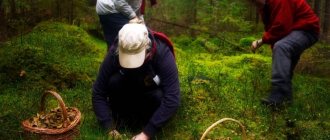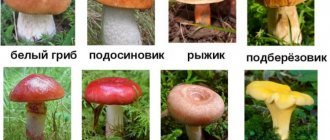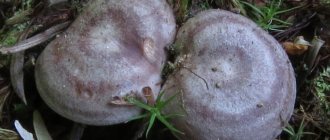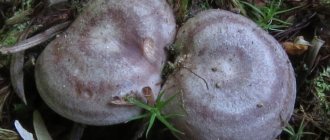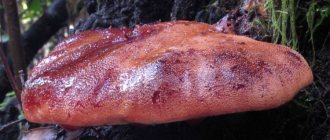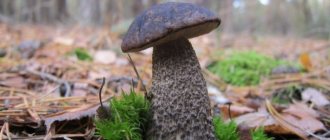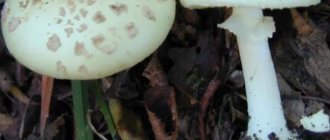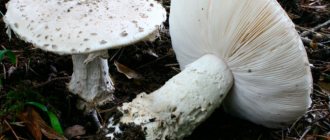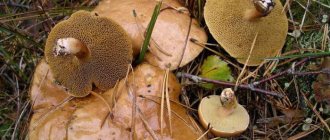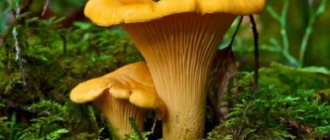The mushroom mushroom has the status of “traditional Russian”. It has always been considered the most suitable for salting or pickling. There are more than twenty separate varieties of this mushroom, all of which are edible. True milk mushroom, also called white or raw, is collected in pine or spruce forests. It grows from approximately mid-July to the end of September. It is usually found in large colonies of fungi. This is precisely what gave the name “milk mushroom” itself - if one was found, then there are several of them nearby. They never grow alone, only in a crowded, “cumbersome” way.
The breast is distinguished by a milky or yellowish cap. When cut, a very caustic milky juice flows out of it, turning yellow in the air. The article will tell you everything about milk mushrooms, as well as where to collect them and at what time, and how not to confuse them with other mushrooms, including poisonous ones.
Mushroom milk mushroom
Milk mushrooms
Milk mushrooms belong to the Russula family, to the genus Lacticaceae. These are representatives of the fungal kingdom that have been sufficiently studied in many respects. All mushrooms belonging to the laticifers are distinguished by the presence of milky juice, a kind of pulp that crumbles easily. The taste of mushrooms varies from sweetish mushroom to bitter and acrid, which makes some representatives conditionally edible mushrooms.
| Group: | Lamellar |
| Color: | Whitish, with a yellowish tint. |
| Peculiarities: | With milky juice |
| Department: | Basidiomycota (Basidiomycetes) |
| Sub-department: | Agaricomycotina (Agaricomycetes) |
| Class: | Agaricomycetes (Agaricomycetes) |
| Subclass: | Incertae sedis (uncertain position) |
| Order: | Russulales |
| Family: | Russulaceae (Russulaceae) |
| Genus: | Lactarius (Millary) |
| View: | Lactarius resimus (True milk mushroom) |
About 20 species of milk mushrooms are the most common and well studied. Black milk mushroom (Gypsy, Nigella, Chernysh, Varen) belongs to category 2 conditionally edible mushrooms. Like all mushrooms, milk mushrooms can reach large sizes. The cap grows up to 20 cm in diameter. The black breast has a funnel-shaped cap, the edges of which are curled. When exposed to high humidity, the skin becomes sticky. The color can vary from dark olive to dark brown. The center is usually darker in color than the edges. The pulp is brittle, dense, and turns gray when broken. The juice is white, abundant with a pungent aftertaste.
The plates descending to the stem, branched, thin, often located. The leg can reach 8 centimeters in length and up to 3 centimeters in diameter. It usually tapers downward, smooth, and sticky. The color is the same as the hat. In young mushrooms it is dense, in mature ones it is loose and hollow. Loves bright places in mixed forests. It often grows in groups among moss, in the grass near forest roads in birch forests. White milk mushroom (white milk mushroom) is radically different from black milk mushroom. And the differences are not only in color, but also in size. The cap of the white milk mushroom reaches 8 cm in diameter, depressed and slightly darker in the center.
Milk mushrooms
The skin of young mushrooms is white and highly pubescent, while that of mature mushrooms is closer to pink (yellow) in color. It feels sticky to the touch. The pulp is white, dense, the smell is weak. The milky juice is white and abundant. The stem of the porcini mushroom reaches 4 cm in height and 2 cm in diameter. Cylindrical in shape, tapering towards the base. Mature mushrooms are hollow. The color is the same as the cap or a little darker. The plates are descending or adherent, narrow and frequent. Young mushrooms have white plates, mature mushrooms have cream or yellow ones.
This species is often confused with pink moth. But the pink wave has a more saturated cap color and concentric zones. In addition, this type of milkfish is more squat than the white milk mushroom.
Real milk mushroom (wet milk mushroom, raw milk mushroom, pravsky milk mushroom) is a mushroom that in mycology is better known as pepper milk mushroom. This type of milk mushroom is larger in size compared to its counterparts. The cap of a real milk mushroom can grow up to 20 cm in diameter.
At the beginning of ripening it is flat-convex, and as it grows it becomes funnel-shaped with pubescent edges turned downwards. The leg of the real milk mushroom reaches 7 cm in height and 5 cm in diameter. Smooth, cylindrical. The color of the leg is white or slightly creamy; there are specimens with yellow spots.
The pulp of young mushrooms is dense, and as it ripens it becomes brittle and hollow. The milky juice is abundant and, when oxidized, acquires a sulfur-yellow hue. The plates are frequent, descending to the stem, wide, yellowish in color.
Milk cap
Leg of white mushroom
A characteristic feature is a short stalk, the height of which does not exceed 5 cm. It is noteworthy that the width of the stalk is the same, which makes the mushroom seem squat. The leg is smooth to the touch, but sometimes small indentations may form on it, especially in adult specimens. In young mushrooms it is dense inside, but as it matures it becomes hollow. The color of the leg is white, but sometimes spots and pits of a yellowish tint can be seen on its surface.
Special attention should be paid to the hat. It is quite large, since depending on the age of the mushroom it can reach 6-20 cm in diameter. At the same time, it is quite dense and fleshy, and in the center there is a characteristic notch. The color of the skin depends on the age of the mushroom and its growing conditions. In most cases it is milky white, but it can also take on a light yellow tint.
Another characteristic feature is that the surface of its cap remains wet and slippery under any climatic conditions, so small leaves or soil particles are often poured onto it. This feature allows mushrooms to camouflage themselves very successfully in the forest.
According to the botanical classification, white milk mushroom belongs to lamellar mushrooms. This is explained by the fact that on the inside of its cap there are sparse plates that smoothly turn into a stalk. The color of the plates directly depends on the age of the mushroom: in young ones they are white or cream, and as the specimen matures they become yellowish.
Leg of white milk mushroom
Milk mushroom pulp
It is considered especially valuable due to the unusual smell and pleasant taste of the pulp. It is quite dense and fleshy, the color is white and does not change when mechanically damaged or cut. Unusual is the fact that the smell of the pulp is not mushroom, but fruity. This is what led to the enormous popularity of the mushroom in the past. It is noteworthy that abroad they are not considered edible, while in our country they are considered a real delicacy. Most likely, this tendency is due to the fact that they require special heat treatment, and when cut, a burning milky juice is released from the pulp.
| Milk mushrooms | Quantity | Norm** | % of the norm in 100 g | % of the norm in 100 kcal | 100% normal |
| 16 kcal | 1684 kcal | 1% | 6.3% | 10525 g | |
| Squirrels | 1.8 g | 76 g | 2.4% | 15% | 4222 g |
| Fats | 0.8 g | 56 g | 1.4% | 8.8% | 7000 g |
| Carbohydrates | 0.5 g | 219 g | 0.2% | 1.3% | 43800 g |
| Alimentary fiber | 1.5 g | 20 g | 7.5% | 46.9% | 1333 g |
| Water | 88 g | 2273 g | 3.9% | 24.4% | 2583 g |
| Ash | 0.4 g | — | — | — | — |
| Vitamins | — | — | — | — | — |
| Vitamin B1, thiamine | 0.03 mg | 1.5 mg | 2% | 12.5% | 5000 g |
| Vitamin B2, riboflavin | 0.24 mg | 1.8 mg | 13.3% | 83.1% | 750 g |
| Vitamin C, ascorbic acid | 8 mg | 90 mg | 8.9% | 55.6% | 1125 g |
| Vitamin RR, NE | 0.15 mg | 20 mg | 0.8% | 5% | 13333 g |
| Digestible carbohydrates | — | — | — | — | — |
| Mono- and disaccharides (sugars) | 0.5 g | max 100 g | — | — | — |
How long do they grow after rain?
The life cycle of the fungus begins with the germination of a spore and ends with complete decay . First, the spore enters moist soil (subject to the temperatures mentioned above). Mycelium then emerges from the spore. In winter, its activity stops, but as soon as favorable factors develop in nature, the mycelium will begin to develop again.
In this case, lumps form between the mycelium threads, from which the fruiting body, the mushroom, grows. The period from the beginning of growth to biological decay lasts, on average, two weeks, but the development of the mycelium itself can last for years . The milk mushroom, as a rule, begins to ripen and reach its maximum size on the sixth day; then only the cap grows.
You will be interested in reading how to prepare salads with salted milk mushrooms.
The mushroom is a slow-growing mushroom, so after warm, drizzly precipitation, it reaches 1.5–3 mm in height within 24 hours . This mushroom’s dense and weighty body does not allow it to “rush upward” quickly. You can go for milk mushrooms 5-7 days after the rain, and they reach full maturity by 7-12 days. The aging of the fruiting body and its saturation with toxins occurs after 2 weeks, so it is not recommended to collect overgrown milk mushrooms.
Where does milk mushroom grow?
White milk mushroom grows mainly in northern regions, but can occasionally be found in other climatic regions. If you go on a “quiet hunt” for these particular mushrooms, you should know that they prefer to grow in deciduous and mixed forests, and are most often found near birch trees, since the fungus forms mycorrhiza with the roots of this particular tree. It makes no sense to look for these mushrooms more often, since they prefer moist and moderately lit clearings, clearings and edges. Milk mushrooms are mushrooms with a slow growth rate (0.2-0.3 cm per day). It takes about a week for them to fully ripen.
When going into the forest for these mushrooms, you should also know that their peak fruiting occurs at the end of summer or beginning of autumn (depending on the climatic region). But, if the autumn is warm, they can be found in October. It should also be taken into account that in hot weather the fruiting bodies develop poorly, so it is better to go for prey with the onset of cool, rainy weather.
Milk mushrooms love moist, mixed coniferous forests. Appear after heavy warm rains. Like all lamellar species, they grow in families, and very quickly: a couple of days - and the “clearing” is ready, you can collect it again. The breast grows in 3-5 days to medium size and continues to grow for 10-15 days. The diameter of the cap and the height of the mushroom increase by 1 -1.5 cm per day. Pay attention to abandoned meadows near the forest - milk mushrooms often take over the edge of the clearing.
To a decisive extent, the growth rate of milk mushrooms depends on the temperature and humidity of the soil and air. The most favorable temperature in the forest is about 22° C, and the humidity is 80-85%. Mushrooms do not like excessive humidity and hot weather. In warm, but not hot weather, they grow faster than in cold weather. There is a significant increase in fungal growth after warm, quiet rains and the appearance of fogs. Low air humidity and dry soil cause their growth to stop. This also occurs as a result of infection of the fruiting bodies by mosquito and fly larvae.
Let's consider in which regions of Russia milk mushrooms are most often found:
- Many of these mushrooms grow in the Krasnoyarsk region. These are Arey, Emelyanovo, Uzhur, Kurtak, the vicinity of Uyar, Bartat, Shchetinkino.
- In the Chelyabinsk region, milk mushrooms can be found in the forest on the western side of Lake Bolshoy Kremenkul, in the forests along the Kyshtym-Ozersk highway, the surrounding forests of Kasley are also rich in milk mushrooms, in the forests around the village of Kureinoye, in the forest around the village of Tomino.
- In the Vladimir region, the villages of Efimovskaya and Smykovo, the villages of Demukhino, Ilyino, Muromtsevo (Sudogodsky district) are famous for milk mushrooms. The village of Pervomaisky (Selivanovsky district), Boldino (Sobinsky district) towards Koloksha.
- In Transbaikalia, milk mushrooms grow in the Tunkinskaya Valley, not far from Irkutsk in the village of Pivovarikha.
- The southeast of the Sverdlovsk region is ideal for collecting milk mushrooms. In the north of the Middle Urals, there are also milk mushrooms, but in smaller quantities, and not every person will follow them into the deep taiga. Wonderful places near the stations Reshety, Sportivnaya, Novoalekseevskaya, near Kamyshlov.
Collected milk mushrooms
When to collect milk mushrooms: collection calendar
In what months is it better to collect white milk mushrooms, other species in 2020 and not only: briefly about the main thing.
In June, you can collect the most heat-loving varieties of milk mushrooms. This is not the peak of fruiting, rather the beginning - but after a generous rain and bright sun, you can collect the following types of milk mushrooms: felt, marsh, oak, camphor, red-brown, pepper.
July is not the best time for milk mushrooms: the mycelium does not like peak high temperatures and drought: only chanterelles are happy! But after heavy rains and fogs, the mushroom picker will be pleased with the first milk mushrooms: real, black, pepper, red-brown, oak, camphor, felt, marsh.
August is the time for white milk mushrooms. And not only! When the hot days are behind us, when fog that is beneficial for mycelium spreads at night, and the morning is greeted with abundant dew, it’s time to collect. And you can collect all the milk mushrooms: both those listed above and the rarer varieties: gray lilac, fluffy, papillary, aromatic.
September is not generous with milk mushrooms in every region, although in the central zone a generous harvest awaits the mushroom picker. And even if there are prolonged rains, even if it becomes increasingly difficult to see the shiny caps under the layer of litter - on the warm days of Indian summer it is worth going for white and black, for other species, and at the same time discover fluffy milk mushrooms, golden yellow, aspen, camphor, tender and others.
October is the deadline by which milk mushrooms can be collected. Not everyone bears fruit at this time – and not in all regions. But in warm years, in regions with a mild climate, you can harvest the last harvest of the year.
Where to find white milk mushroom
It is worth noting that white milk mushroom is considered a rather rare mushroom, but it forms large families, so if you are lucky enough to find a place where it grows, you can immediately reap a rich harvest. In addition, it should be borne in mind that they grow in the same places every year, so if you manage to find such a clearing in the current season, be sure to remember this area and visit it again next year.
It should also be taken into account that these mushrooms are very skillfully camouflaged in the area. Their short stem is almost completely in the ground, and leaves and soil particles often stick to the cap. Therefore, if you find one specimen, carefully examine the entire clearing: it is possible that you will be able to reap a very rich harvest. At the same time, try not to damage the fragile cap or the mycelium itself, since in this case the mushrooms will stop growing in this place.
Post-harvest processing
Milk mushrooms are very tasty and healthy mushrooms, but picking and cooking them is an art. However, they quickly deteriorate. If you don’t sort it out in time, they will become moldy and tasteless. Therefore, they need to be processed as soon as you collect them. First you need to sort them out and put the wormy ones in a separate container. Then, if the milk mushrooms have a strong smell, you need to wash them.
To do this, soak in water for several hours to remove the bitterness. Then the mushrooms are washed again and poured with cool water so that they are saturated with moisture. After this, the milk mushrooms are placed in a colander and put on fire. Boil for about half an hour.
1-Japanese breast. 2-The breast is yellow.
Place in clean jars and add salt, pepper, bay leaf and various seasoning sauces that you prefer. Jars of mushrooms are placed in a cool place. After a week, milk mushrooms can be eaten if they are well salted. If you want to make a salad from them, be sure to soak them for 40 minutes in salt water, then drain the water. In this form, boil it in salted water, add butter, finely chopped herbs and season with mayonnaise.
Real breast milk (Lactarius resimus)
The most famous species with excellent taste. The cap is fleshy, at first spread out and then pressed in the center, with curved fringed edges, reaching a diameter of 20 cm. The skin is milky or yellow in color, sometimes with reddish spots, slimy in rainy or foggy weather. The leg is smooth, up to 6 cm high, with frequent creamy-white plates descending onto it. The pulp is tight, white, with acrid juice, turning yellow at the break. This is the best species for pickles, in which the fruiting bodies take on a light blue tint.
Real milk mushroom
Loads
Milk mushrooms, as already mentioned, belong to the group of milkweeds. That is, when they break, they always secrete milky juice. But the loads do not release such juice either at the break or at the cut. But in shape and appearance they are exactly the same.
Are milk mushrooms real? Some mycologists call them milk mushrooms, while others object, demanding that these mushrooms be defined exclusively as russula. However, lovers of quiet hunting themselves, leaving disputes to specialists about the clans of the mushroom kingdom, call the loads dry milk mushrooms. Our most famous podgrudok is white (cracker) and podgrudok is black.
White loader (cracker)
The cracker lives up to its name one hundred percent. His hat is dry, rough, matte white, and does not have any mesh fringe along the edge. The mushroom remains dry even when broken, although it has a characteristic mushroom smell.
The size of the cap, like that of real milk mushrooms, can reach 20 cm in diameter. At first the cap is flat, then it becomes funnel-shaped and turns yellow. What makes the cracker similar to a real milk mushroom are the brownish spots that appear on the cap. The plates are bluish-white. The pulp is white, dense, sweetish taste, does not change color when broken.
White podgrudok (Russula delica)
Inexperienced mushroom pickers often confuse mushroom pickers with real mushrooms. This mistake is also possible because the cracker, like its real brother, hides from the eyes of the mushroom picker under the forest floor. And it’s not easy to find a young seedling, because the fruiting body of the cracker begins to form underground.
In general, both mycologists and mushroom pickers have very contradictory opinions about it. Officially, it is included in the II category of mushrooms. However, some believe that the podgruzdok, if it is inferior to anyone in taste, is only to saffron milk caps, but not to milk mushrooms.
White podgruzdok is very tasty when salted. Some people prefer to eat it by boiling it in salted water, hot, with sour cream. You can also fry it, and it’s better not alone, but in company with other mushrooms.
Loader black
Another representative of milk mushrooms is the black milk mushroom. Its cap, from 5 to 15 cm in diameter, is first convex, and then depressed in the middle and funnel-shaped. In young mushrooms it is dirty gray, in adults it is brown or dark brown. The skin of the cap is slightly sticky to the touch and cannot be removed. The pulp is initially white, brittle, then brownish-gray, turns red when broken, and then turns black. The descending plates are whitish, grayish with age, and turn black when pressed. The leg is cylindrical, solid, smooth, the same color as the cap, and also darkens when pressed.
Black podgrudok (Ruussula aduusta)
Podgrudok black is a category III mushroom. It can be consumed fresh, salted, but always after preliminary boiling. It is not very popular among mushroom pickers due to its rather low taste, as it has a peculiar smell of damp earth.
Aspen milkweed (Lactarius controversus)
The cap is at first flat-rounded, with an elevation in the center, later concave, up to 30 cm in diameter, white, with reddish or purple streaks, slightly pubescent. The plates are dense, white with a pink tint, descending onto a dense stalk up to 8 cm high, which becomes narrower at the base. The pink tint of the plates is the main difference between this species and other laticifers. The pulp is milky-white, with a fruity aroma; when crushed, it releases a caustic white liquid that does not darken in air.
Aspen milk mushroom
Doubles
It is important to collect carefully, since very often baskets contain inedible white doubles, which are also called “false whites.” Therefore, you should know their features
The gall mushroom (Tylopilus felleus) or bitterling from the genus Tylopil has an external resemblance to young oak boletus. It has the same convex cap of a brownish or brownish color. The leg is oval-shaped, thickened at the base and covered with a mesh pattern. The color of the finely porous tubular layer is not typical for boletus mushrooms; it is pink or off-white. But the main difference is the very bitter taste, which even repels insects. Therefore, the double always looks flawless.
The satanic mushroom (Boletus satanas) also belongs to the genus Boletus. It has a cushion-shaped cap and a barrel-shaped stem. The cap is grayish-white, olive or brownish. The tubular layer is orange or any shades of red. Characteristic features: the mesh leg in the middle has a rich red color, and when cut within five minutes the flesh turns blue. Old individuals have the smell of rotting onions.
Oak milkweed (Lactarius insulsus)
The cap is spread out, then funnel-shaped with edges turned down, up to 12 cm in diameter. The skin is brown-orange, with a reddish tint, covered with brown spots. Yellowish plates descend on the stem of the same color. The pulp is fleshy, creamy white, when broken it acquires a pink tint and releases a watery white liquid with a pungent taste and a slight mushroom odor. The mushroom is used for pickling and is considered conditionally edible. Another name for oak milk mushroom is oak milk cap.
Oak milk mushroom
What mushrooms should you absolutely not take?
There is a certain time when you can collect milk mushrooms, which live up to 15 days. So, you should absolutely not collect old mushrooms, because they produce toxins.
You cannot pick mushrooms that have dark spots on their caps or that have an empty stem. When can you collect milk mushrooms? When they are young and do not grow along roads or polluted areas, since these mushrooms are capable of accumulating foreign toxins.
Black breast (Lactarius necator)
This dark mushroom is very tasty in pickles, acquiring a wine-like, reddish hue. The cap is rounded-flat, later sunken, up to 20 cm in diameter, brownish-yellow with an olive tint or dark green, the surface may be covered with concentric circles. The edges are curved, slightly fringed. The skin is slimy, especially in rainy weather.
A greenish sticky stalk up to 8 cm high, tight and full, becoming hollow towards the base, the surface is covered with dents. In the upper part, thinned plates of a yellowish-olive color descend on it. The white flesh is fleshy, greyish when crushed, releasing a milky liquid that turns purple when exposed to air. The cap is often dirty, the surface is covered with soil particles and debris, and it has to be scraped off before cooking.
Black breast
Loving team
In Russia, properly salted milk mushrooms are considered a very savory snack due to their fruity smell and dense and crispy texture. In the north and in Siberia, the Volga region and the Urals, milk mushrooms are very popular.
Both young and old know when to collect this “forest meat”. And in terms of taste, some types of milk mushrooms, especially those belonging to the first category, are actually superior to meat in certain indicators. Real milk mushrooms grow mainly on sandy soil and always in groups. Known since the times of Kievan Rus, these mushrooms in their name imply their accumulation in one place, a pile or heap.
White milk cap (dry milk mushroom) (Russula delica)
White cap is a tasty and aromatic type of russula, the cap is whitish-cream with brown streaks, up to 20 cm in diameter, rounded-convex and then concave. The plates are frequent, creamy-white, falling on a straight or slightly curved strong stem. The pulp is tight, creamy, with a subtle mushroom aroma and pungent taste. The surface is usually covered with ingrown soil particles. In dry weather, dry fabrics can crack like parchment, which is why the padding gets its second name.
Loader white
Butter
Once I had the opportunity to collect boletus in the third ten days of October. The culmination of autumn was frosty, the first snow was in no hurry. In the young pine forests - on the frozen “petrified” litter, among brittle, frost-covered grass - there were thousands of “freshly frozen” boletus, among which there were almost no worms. Nobody collected them, since people considered these mushrooms to be already spoiled. But in vain. After all, they were frozen once and have not yet been thawed. Yes, in the heat they became loose and dark, but they smelled good during cleaning. However, in boiling water, the butter quickly lightened and released all its aroma into the broth. The mycelium turned out to be breathtaking, and as it seemed to me then, even tastier than the one I ate in the summer - made from fresh, not frozen mushrooms.
Butterflies are another mushroom that grows in the fall, and at times they can be collected before the very first frost or even from under the snow. The main thing is that the weather is calm and clear.
You can read more about boletus mushrooms in the article: “Boletus mushrooms: 25 varieties.” In the list below I will describe the most autumn ones.
Summer oil can
He is also a grainy butterdish, an early butterdish.
Mycorrhiza forms with pine, bears fruit from June to October, but sometimes it is observed in the second half of May (for which, it would probably be worth classifying it as a spring mushroom) and early November.
Clinton grease can
Named after the American naturalist, this mushroom is popularly known as the chestnut butterfly or girdled butterfly, but most often it is confused with the very similar larch butterfly.
Clinton's oil can grows under the larches. Fruits from July to October.
Oil can Nyusha
Another mushroom named after the scientist - a German botanist.
Just like the previous butterdish - it forms mycorrhiza with larches. Distributed very widely in the temperate zone of the continent; it likes to climb high into the mountains. Fruits from July to October.
Swamp oil can
He is also a yellow swamp butterdish. It has a very expressive, memorable color towards yellow and golden tones. Purely autumn mushroom.
A lover of damp lowlands, river floodplains, the edges of lakes and swamps - all those places where it is more humid. Mycorrhiza forms with Scots pine and some other double-leaved pines. Fruits from September to October.
Oil can sour
It has somewhat loose pulp and is inferior in taste to ordinary boletus. The mucus covering its cap has a sour taste, which is how the mushroom got its name.
Mycorrhiza forms with five-coniferous pines, including Siberian cedar. Very common in Western Siberia. Fruits from July to early October.
Oil can yellowish
The lower surface of the cap of this mushroom has a pleasant ocher tint.
Distributed quite widely, found both in Eurasia and North America. Grows under double-leaved pines, including common pine. Fruits from June to October.
There is information that the skin of the cap of this butter dish has powerful laxative properties, so it should be peeled off before cooking.
Red-red oil can
He is also known as the Trentian butter dish, the Tridentine butter dish, known for its good taste.
A very rare mushroom that forms mycorrhiza with larches. The fruiting period is from June to October.
Places of distribution and time of collection
More often, these mushrooms grow in large groups, families, or, as mushroom pickers say, “flocks,” in late summer and autumn in deciduous or mixed forests. The true milk mushroom is a common species, found quite often in light deciduous or mixed forests, among linden and birch trees. It inhabits small clearings and sometimes quite large colonies. The best soils for its development are those with white clay close to the soil surface. Mushrooms are collected from July until frost.
Connoisseurs especially value autumn harvests - the fruiting bodies are not so well stored, but also do not have an acrid bitterness. Under thin aspen trees, according to its eloquent name, aspen mushrooms are found, forming neat clearings, not far from one another, fused together in the form of chain links. It likes to settle near the root system of poplars of various types, often growing in poplar plantations and forest belts. The collection time is only two months long - August and September.
The bright yellow milk mushroom has taken a liking to spruce forests - small close groups of these mushrooms grow under the thick paws of dark spruce trees; less often, it forms entire clearings. Harvesting occurs in late summer and early autumn. Oak milk mushroom grows in numerous families in oak forests, prefers soft calcareous soils, and settles in abundance on the slopes of warm, sun-warmed hills. Tight greenish fruiting bodies of this species are found from late summer until frost.
The main signs of cargo places
Milk mushrooms, like many other mushrooms, are symbionts of higher plants. They enter into a kind of “alliance” with trees - they exchange nutrients with them through the root system and ensure better water absorption. Pundits from mycology [1] Mycology is the science that studies mushrooms. They came up with a scientific name for this union - “mycorrhiza”.
Photo 2. An old birch forest is a typical forest where milk mushrooms grow.
Which trees milk mushrooms form mycorrhiza with is a separate question, but it has long been noted that most species of these mushrooms have a special passion for deciduous trees, especially birch. That is why birch forests and forests mixed with birch are the first landscape where milk mushrooms grow. However, in purely coniferous forests, certain varieties of these mushrooms are also found, but they are a minority.
When searching for milk mushrooms, you should definitely take into account the age of the trees that make up the forest, because the mycelium needs a certain number of years to develop.
Simply put, in very young forests, where the height of a tree is comparable to the height of a person, there is no point in looking for mushrooms; here you are more likely to find boletus and milk mushrooms, but not milk mushrooms. But in older plantings, the chances of finding the coveted mushroom increase noticeably. Finally, in old forests you will definitely come across milk mushrooms.
In addition to specific trees, other conditions are also important for different types of milk mushrooms - the type of soil, the amount of moisture in it, how it can retain it, and also how well the sun's rays warm the place. These parameters vary for different milk mushrooms, but it has been noted that most varieties avoid overtly dry or wetlands, preferring moderately moist soils well warmed by the sun - with grass, moss or a litter of rotted leaves. By the way, fruiting bodies are often partially or completely hidden under a layer of soil, which the mushroom picker should take into account first of all during collection (usually people arm themselves with a stick and pick at all suspicious tubercles with it, and some especially clever ones use small rakes).
Perhaps now is the time to take a closer look at the varieties of milk mushrooms and the places where they grow.
Pepper milk mushroom
Light mushrooms grow in clearings or rows in deciduous forests, rarely among conifers; they love dampness and dense shade. The cap is up to 20 cm in diameter, convex or flat, then concave, cream-colored, with a lighter shade along the edges; brown spots quickly appear at the site of damage. The pulp is dense, but fragile; at the break, a viscous white liquid is released, the taste is acrid, with a taste of hot pepper. Eating is permissible in salted form and only after prolonged soaking with frequent changes of water. Dry powder from fruiting bodies is used as a spicy, hot seasoning.
Pepper milk mushroom
At what temperature do they grow?
The most acceptable temperature for the start of fruiting is considered to be +8...+10°C above the surface of the earth . Most varieties of mushrooms avoid places that are too wet or, on the contrary, dry, choosing moderately dry areas. It is best to go picking mushrooms after a long drizzling rain, since after a downpour the fruiting bodies quickly rot. If the soil is highly moist, mushrooms germinate within a few days.
Did you know? Once upon a time, the harvest of the year “for mushrooms” was determined by folk wisdom. If it rained on Annunciation Day, expect a bountiful mushroom season, and if the frosts “returned,” expect a harvest of milk mushrooms.
Camphor milkweed (camphor milkweed)
Camphor milkweed often grows near conifers on damp, mossy soil and on decaying wood. The cap is 5–6 cm in diameter, convex, then concave, with a wavy edge, glossy, reddish-brown. The plates are pinkish, then brown, descending onto an even thin stalk up to 5 cm high, tuberous in shape at the bottom. The pulp is brittle, loose, brick-brown, with a very strong, rather unpleasant smell of camphor or dry clover. At the break, a whitish juice is released that does not change color in air. The characteristic smell will prevent the mushroom from being confused with others, as well as being used as food.
Camphor milk mushroom
Deceptive bitterness
Confusion arose with this mushroom, since in Russian mycological literature in the early 19th century, the pepper mushroom was considered to be the real mushroom. The bitterness is felt even in the name.
For the most part, milk mushrooms are really bitter, and are eaten only after a long soaking, lasting at least three days, and only in salted or canned form. The container for pickling should be either wooden, glass or enamel. Due to its bitterness, not all mushroom pickers are fans of Lacturius resimus; some avoid it. In the West, it is clearly considered inedible.
Violin (felt weight)
In oak forests and birch forests from mid-summer to October you can find violin - a conditionally edible mushroom with a pungent taste that grows in large clearings. The white cap is fleshy, covered with villi, concave, later taking the shape of a funnel, with bent edges, up to 25 cm in diameter. The plates are creamy-white, sparse, descending on a rounded stem up to 8 cm high. The pulp is white, fragile, and when broken it releases a caustic milky white juice. The leg is almost completely buried in the ground, so only the violin caps are collected. Before cooking, they are soaked for a long time and then used for pickles.
felt milk mushroom
Early morning is the best time to collect
There are other variants of the name - from Hebrew “milk” is translated as having a hole. Indeed, the cap of this milk mushroom is funnel-shaped. Many fans of the “king of mushrooms” are milk mushrooms. When to collect these gifts of the forest, at what time of day is it more effective to do it? It is recommended to go for them early in the morning, around 5 o'clock. It is advisable to have a long stick with you to check each suspicious bump, since Lacturius resimus are perfectly camouflaged under fallen leaves and in the grass.
Golden-yellow milkweed (golden milkweed)
In the dampness of coniferous or mixed forests, as well as in birch forests, golden milkweed, classified as a conditionally edible mushroom, grows singly or in clearings. The fleshy cap is light yellow, darkens and turns purple where touched, the velvety edges are curved down. The shape is prostrate, then concave, the surface is sticky. The plates are yellowish, frequent, descending on a pale yellow high stalk. The pulp is creamy-white, secretes a caustic milky liquid with a pleasant odor. Suitable for pickles and preparing marinades after soaking or cooking.
Milk breast golden yellow
False white mushroom: photo and description
It happens that the baskets of inexperienced lovers of “silent hunting” end up with specimens that are very similar to white ones, but in fact are their poisonous “doubles”.
Without sufficient experience and the necessary amount of theoretical knowledge, it is quite easy for a person to make a mistake. After all, false whites grow in the same places as edible ones, and in close proximity to them. That is why it is necessary to learn to distinguish between real species and their poisonous “doubles” (Figure 4).
Characteristic
To learn how to accurately recognize inedible doubles, you need to familiarize yourself with the photo and description of the false mushroom and its main types.
The most dangerous to human health and life are bilious and satanic (Figure 5). Gall, called mustard, is found on well-warmed sandy or loamy soil at the edges of coniferous forests. Therefore, it is easy to confuse it with pine, although it looks like oak.
And yet, if you doubt its edibility, learn to test it using less risky methods
Pay attention to its appearance. The gallstone looks impeccable because due to its bitter taste, neither animals nor insects eat it
Figure 4. The main boletus twins and their characteristics
Satanic is similar in appearance to oak, and can be found in warm oak forests, next to linden and hornbeam trees. And although the scientific literature classifies it as conditionally edible, you should know that consuming it raw is extremely dangerous, since even a young specimen produces a sufficient amount of poisons to harm human health and life.
Description
In addition to the same place of growth, the gall mushroom is similar in appearance to the edible one. It has the same convex brown cap and a cylindrical leg thickened at the base with a network of veins. The difference lies in the color of the tubular layer: in the gall layer it is pinkish or dirty white, which is not at all characteristic of the present one. Yet the main difference is the very bitter taste.
As for the Satanic one, its cap is quite pleasant to the touch and can be painted in gray, olive or brown colors
Just as in the case of bitterling, you should pay attention to the color of the tubular layer
In addition, the flesh changes color when cut - from yellow or white it turns blue within a few minutes, and it is advisable to check the mushroom right in the forest. The unpleasant smell of rotting onions, characteristic of overripe specimens, should also alert you.
What is the difference
Although edible whites are represented by several species, each of which has its own notable characteristics, there are a number of characteristics common to all true species:
- Their tubular layer can only have a white, yellow or olive color, while the bitterling plates are colored in pinkish tones, and the tubular layer of the satanic has bright orange-red shades.
- Edible specimens have dense pulp without a pronounced taste or smell; in poisonous specimens it is watery.
- The pulp does not change its color at the break even during heat treatment. But the pulp on the cut of the gall fungus acquires a pinkish-brown tint. Satanic changes the cut color to purple.
- Among other mushrooms, forest dwellers often leave traces of their vital activity on white mushrooms, using them as food or as a place to breed offspring.
Figure 5. The main types of inedible porcini mushrooms: 1 and 2 - gall, 3 and 4 - satanic
No matter how large the mushroom is, give preference to smaller, but younger specimens, because it is well known that the older the mushroom, the more dangerous substances it accumulates.
False breast
Milk mushrooms have no poisonous counterparts. False milk mushrooms have a specific smell or taste, but are not poisonous. They are used in cooking after drying, boiling or long soaking.
Skripun
The skripun mushroom (violin mushroom, felt mushroom) is similar to the real one and is edible. It does not have as pleasant a taste as real milk mushrooms. His hat is white and fleshy. The shape is concave, later funnel-shaped, covered with villi, the edges are curved, the diameter of the mushroom reaches 25 centimeters. The plates are infrequent, creamy-white, descending on a rounded stalk, the height of which reaches 8 centimeters.
Milky fragrant
The breast milk can also be confused with the aromatic milkweed. The cap is up to 7 cm in diameter, slightly pubescent, depressed, brownish-gray, with a pinkish, yellowish or purple tint. Concentric circles are faintly visible. The plates are attached with a tooth to the stem, frequent, pale ocher.
The leg is cylindrical, whitish with a yellowish tint, hollow. The pulp is whitish or reddish-brown, with the smell of fresh hay. The milky juice is white, turns slightly green in the air, is slightly sweet in young mushrooms, and slightly acrid in old mushrooms. Grows in coniferous and mixed forests in August - September. Conditionally edible, used for pickling with other mushrooms, but sometimes also fresh.
Milky fragrant
Pepper milk mushroom
The pepper mushroom has a flat or convex, later concave cream cap, the diameter is 20 centimeters. The edges of the cap are a shade lighter. The cut areas on the mushrooms quickly darken. The pulp is acrid in taste, has the taste of hot pepper, is fragile, and dense. They can be consumed salted, after long soaking and frequent changes of water. Dry mushroom powder is used as a spicy seasoning.
Gorkushka
Bitter milk or large bitter mushroom. The cap is reddish-brown. A small bump is visible in the center. Funnel-shaped. The leg is solid and thin. A bitter milky juice appears on the cut. The pulp is dryish, slightly brown, dense. Bittersweet grows in mixed and coniferous forests. Used in salting and pickling after soaking and chilling.
Gorkushka
What can you cook
Milk mushrooms have a pleasant and delicate taste, have the aroma of fresh cucumbers and can be used for making pickles and jams, soups and many other dishes.
The soaking time depends on the size, usually from one to three hours.
First - in cold water, then - in boiling water. This is done in order to check if there are any parasites in the mushroom. If they are, then it is better not to take milk mushrooms. After this, the mushrooms must be soaked in salt water for 2-3 days. Then the milk mushrooms must be washed and boiled again. They should also be cooked for several hours, after cutting off the stems of the mushrooms. After cooking, rinse several times in cold water. Now you can start salting them.
Expert opinion
Gennady Sergeevich Rylov
A great expert in mycology and an avid mushroom picker. Knows everything about mushrooms, their types and places of growth
The stems of milk mushrooms can be used to make mushroom soup. But it’s better to marinate or pickle the caps.
Roasting. You can prepare a lot of delicious dishes from milk mushrooms that will appeal to all family members and guests. First, you should freeze them well so that they do not become bitter, after which they should be thoroughly washed. Then you need to boil in salted water for 15-20 minutes over low heat. Drain the water, dry the milk mushrooms and fry in vegetable oil. After which they can be served.
You can also marinate mushrooms. To do this, the milk mushrooms need to be washed, peeled and cut into small pieces. Then you need to fill it with water and put it on fire. When the water boils, add salt and spices. Cook the milk mushrooms for 20 minutes, after which they should be removed from the heat, the mushrooms removed, and the broth drained.
Then you need to take an enamel pan and put the mushrooms in it. Pour all this over the mushroom broth, which must first be boiled, and cook over medium heat for about 40 minutes, stirring occasionally. At the end you can add vinegar. And after this, the mushrooms can be considered ready.
Next, they need to be transferred to a jar, filled with prepared brine, and closed with a lid. The finished milk mushrooms should cool. During this time, they will absorb the brine, so you need to make sure that the jars do not overfill. After a day you will be able to eat. Their taste is very unusual; the mushrooms resemble pickled cabbage or pickled cucumbers. They go well with sour cream and garlic.
They can be dried or salted . It is recommended to dry mushrooms at a temperature of 50-60 degrees.
To salt the milk mushrooms, place them in a thin layer on a baking sheet lined with baking paper. They are superior in taste to many mushrooms. They contain many substances beneficial to the body, so they are an excellent food product. During salting, they acquire a dark color, after which they become truly tasty.
What temperature is needed for mushroom growth?
Good to know! On average, mushrooms in the forest grow at a temperature of 18-28 degrees Celsius. However, these figures are not strict, since each type has its own limits. Knowing the growth temperature of mushrooms is necessary not only for those who grow them, but also for those who like to collect them in the forest.
Interesting materials:
How long before departure to the airport? How long does it take to digest whey protein? How long does it take to board an Aeroflot flight? How long does it take to board for domestic flights? Why an 11 month lease? Why inject steroids? Why do they wear a ring on a chain around their neck? Why is VSAA needed? Why do you need a Ukrainian passport? Why is an arch needed?
Kinds
There are several types of milk mushrooms:
- real,
- black,
- aspen,
- turning blue,
- yellow,
- oak,
- creaks or violins.
Real
This mushroom belongs to the first category mushrooms. It is also called raw because of its slimy cap. It is found in the Urals or Siberia, in birch forests and young forest plantations. It has a characteristic hollow stem and funnel-shaped cap. The color is milky white, with faint stripes. After salting it acquires a bluish tint. When salted, they are very tasty and aromatic.
Black
These representatives of milk mushrooms can bear fruit until frost. They chose country roads, clearings, forest edges, as well as birch and alder plantings. Because of the rich greenish-black color of their caps, they are often called nigellas or gypsies. According to the description, they are similar to other types of laticifers with a typical funnel-shaped cap and a hollow stem. Nigella is considered an excellent mushroom for pickling. And although it belongs to the third category, it surpasses many milkweeds in nutritional value, since it can be stored for about three years without losing its taste.
Aspen
The name of this milk mushroom speaks for itself, as it is found mainly in sedge forests. Aspen milkweed is a fairly rare mushroom, and it is usually used for pickling. Its hat is dirty white with frequent creamy-pink plates. The leg is strong, also white.
Turning blue
This milk mushroom is incredibly tasty when pickled. However, many mushroom pickers are afraid to collect it. When touched, it instantly turns blue, and the milky juice turns purple when cut. The plates are rare, purple. Found mainly in Siberia.
Yellow
This mushroom does not inspire confidence among mushroom pickers, although it belongs to the edible mushrooms of the first category and is a colored double of a real mushroom. Distributed in young coniferous and fir forests. Experienced lovers of “silent hunting” may be confused by its cap with small spots - this is a characteristic feature of this species.
There are many edible mushrooms in our forests, but only three species belong to the highest category. The “holy trinity” includes white, saffron milk cap and milk mushroom. Unfortunately, the latter is now undeservedly forgotten.
Many “mushroom pickers” have recently been of the opinion that this mushroom is on par with toadstools in its qualities. This is far from true.
In ancient times, it was not for nothing that it was called “royal”, since in terms of taste and nutritional qualities you are unlikely to find anything similar. So when are milk mushrooms collected? To begin with, we will provide at least basic information about their appearance.
In appearance, this is an ordinary representative of agaric mushrooms with a wide and massive cap. The shape is funnel-shaped and the color varies from white to cream. In “patriarchs” its diameter can reach 20 cm.
An important sign: this mushrooms are always slightly damp, and this does not depend on the weather. And now let’s move directly to the topic of when milk mushrooms are collected.
It is traditionally believed that you need to look for them from the second half of July to the beginning of October. The highest probability of meeting them is in birch groves. Quite often they can be seen in areas with a predominance of deciduous trees. Having found one mushroom, carefully look around: most likely, you will find a dozen more.
Please note that they grow best in lowland areas, as they do not tolerate dry soil at all. If sandy and dry soil predominates in the forest, then you don’t have to look for these mushrooms.
Let's look at when milk mushrooms are collected, depending on their type.
- Real, oak and can be found from the second half of July to September.
- The blue variety is searched for from the second half of July until the end of August.
- Yellow and pepper species can be obtained from late July to early September.
- your cart will be visible if you go for it from the end of July to the end of September.
Of course, all these terms are quite arbitrary. You just need to remember that when milk mushrooms are collected, the forest must be quite humid. We have already said that you will never find them on dry land.
In addition, look at the local vegetation: if you see thickets of horsetail, then with a high probability you can assume that you will not find a single mushroom. This plant is the first sign that they cannot tolerate it.
It is generally accepted that you only need to collect classic milk mushrooms, although this is not the case. Although its varieties are not so valuable in nutritional terms, their taste is no worse. Their method of processing and salting is no different. The black variety is especially good, which, after salting, acquires a beautiful reddish color.
Remember how we said that milk mushrooms used to be very valued? How to cook them so that you end up with a delicacy?
First, they need to be soaked in running water, and the process should last at least two days. The water needs to be slightly salted and changed frequently, as the milky milk juice can spoil the taste of the dish. Only after this can the mushrooms be salted. After a month of standing under oppression, they will turn into a food quite worthy of a royal table.
That's what they are - milk mushrooms. You already know when to collect them.
Dedicated to all mushroom pickers and lovers of delicious snacks. In this material we will study in detail information about milk mushrooms. It will be interesting.
The breast is considered a real Russian mushroom. In Western, Eastern and Southern countries they don’t even know about them.
In our region, these mushrooms were able to firmly enter the consciousness of every person. They are considered the most wonderful forest gift, and therefore have won the hearts of our compatriots.
In many regions of Russia, for example, in Siberia, these mushrooms were one of the types of industrial mushrooms for a long period of time. Ideal nutritional properties combined with widespread fruiting are why they are in demand among people.
The main purpose of the mushroom is pickling. Other dishes must be prepared from salted preparations. But mushrooms are not suitable for frying, stewing and other similar cooking methods.
Milk milk contains so much protein that it can easily replace meat. The particular benefit of the mushroom is that it is used to create drugs that fight tuberculosis. After all, the components of the mushroom are able to neutralize the dangerous Koch bacillus. Next, we will consider in detail the types of mushrooms.

